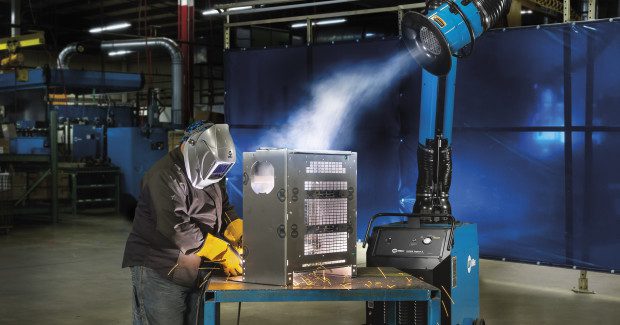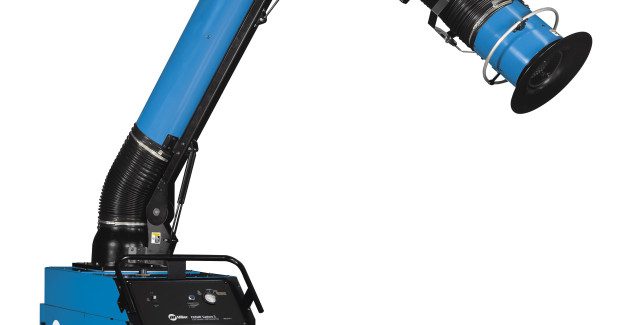New Technology Expands Work Envelope When Using Fume Extractors
Source capture is the recommended method of fume extraction because it removes contaminated air at the source, before it reaches a welder’s breathing zone. Recent advancements in source capture technology create a much larger capture area than what’s available with existing systems and can minimize how often the welder has to move the extraction arm.
Posted: December 17, 2013
Welding is what I know. But if I know anything about welding, it’s that I know nothing about welding. That’s because there’s so much to know, and it changes every day with new technologies and improvements.
Being a welding aficionado (aka welding nerd), a new advancement in welding fume extraction has me excited about fume extraction, of all things. This new technology helps welders increase their work envelope, and it changes the game for fume extraction.
Fume extraction offers several advantages for companies and welders. Better air quality means a cleaner work environment, reduced maintenance costs on equipment and increased lifespan of the many tools in the shop. Utilizing fume extraction also helps companies comply with regulations from the Occupational Safety and Health Administration (OSHA) to reduce employees’ exposure to fume particulates and airborne elements.
There are many different types of fume extraction systems, with each having its own advantages and best applications. Source capture is the recommended method because it removes contaminated air at the source, before it reaches a welder’s breathing zone.
http://youtu.be/FZwO1chLAOg
The FILTAIR® Capture 5 weld fume extractor features exclusive ZoneFlow™ technology that creates a much larger capture area than existing source-capture products and is far more effective than ambient capture systems.
Recent advancements in source capture technology have created a much larger capture area than what’s available with existing systems and minimize how often the welder may have to move the extraction arm. The technology (here comes the plug), exclusive to the new Miller Capture 5 fume extraction system, works by essentially creating a low pressure pocket or a negative zone of air in your shop.
This system creates a negative air pressure zone, which forms a type of curtain that funnels the weld fume particulates that are inside of the capture zone toward the center of the arm. Air is suctioned into the arm at a standard fume capture rate of around 900 cfm, while simultaneously, clean filtered air moves out of the arm at about a 90 deg angle to the unfiltered air coming in. This creates an “air barrier” that basically increases the effective diameter of the hood on the end of the arm.
Some of this clean air blows out of the arm and circles back in, and in effect, creates a “funnel zone” that removes fume particulates. The return air in combination with the extraction creates the negative pressure zone that is about 5 ft deep and about 3 ft wide. This is a HUGE work envelope as compared to existing fume extraction systems. Most source capture fume extraction systems require the capture hood to be 6 in to 18 in from the welding arc.
All these actions combined create a very defined area of source capture, which funnels the weld fume particulates toward the center of the arm to maximize the extraction process. Typically, about 95 percent of the weld fume in the area is removed using this technology.
We are all always looking for ways to increase productivity; we can do this by increasing worker comfort and safety by creating a cleaner work environment in the immediate welding zone. A comfortable worker is more productive. The significantly wider and deeper capture zone with this new technology means better productivity by reducing the number of times the operator has to stop to move the arm. This increases your operating factor (arc-on time), allowing you to deposit more weld metal in the same workday.
Each stop and start of a weld can potentially increase the number of weld discontinuities, so reducing these translates to a benefit in weld quality as well. This is especially helpful when making long, continuous welds.
Vision obstruction can also be a concern that can impact weld quality and welder safety. Improved source capture technology can make a difference by minimizing weld fume accumulation on the helmet lens. Having a system that captures fume at a greater distance also helps reduce vision obstruction.
OSHA and the American Conference of Governmental Industrial Hygienists both have established limits for the elements, such as manganese, in welding fumes, aimed at maintaining safe work environments. Changes to OSHA’s hexavalent chromium standard also have driven companies to seek out weld fume management solutions that help them comply with the regulations. Companies looking for ways to meet the increasingly stringent OSHA regulations regarding fume exposure may find benefits in this new source capture technology.
Welders will find that a few other aspects of the advanced source capture technology also can help create a better work environment. When working in restricted areas, for example, welders can adjust a dial to narrow the fume capture area and direct the capture area. This increases suction and prevents the discharge airflow from deflecting off parts or swirling around. This means airflow won’t interfere with the shielding gas coverage and lead to weld quality issues.
On the maintenance end, automatic filter cleaning mechanisms utilize a reverse pulse cleaning cycle to clean the filter from the inside out every time the operator shuts the system down. This saves time and extends both the filter’s life and its ability to effectively filter the air.
The fume extraction capabilities of such systems work best when the extraction arm is placed at 30 deg to 45 deg off horizontal, either in front of or at the side of the weld area. That way, backfill air can flow freely and any fumes are pulled away from the breathing zone. One thing about the advanced source capture technology is that it works best when strong air currents or turbulence are kept to a minimum, like what you might get from fans or open doors.
It is recommended to consult with a certified industrial hygienist or source capture equipment provider for recommendations that are best for each welding environment. If the fume management needs exceed those of a source capture system, experts can offer tips to help address the issues and recommend alternative solutions.

















